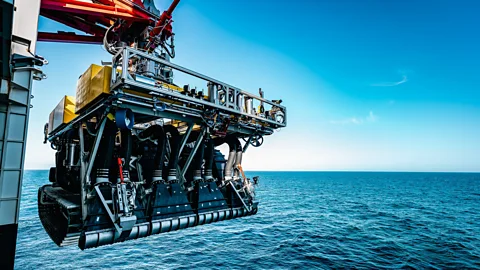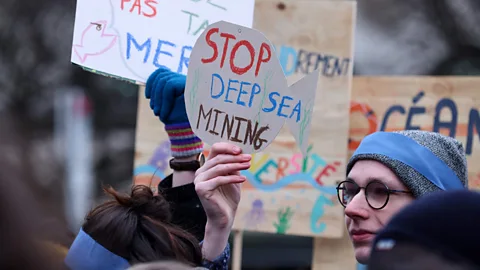The looming threat of deep-sea mining
 The Metals Company
The Metals CompanyA new international treaty aims to protection of the high seas – what will this mean for deep-sea mining?
On 5 March, the world reached what could well be a turning point for protection of the world's oceans.
With almost one in 10 species at risk of extinction, and the growing pressure from climate change, the treaty provides a framework for setting up protected areas in the high seas, sometimes known as international waters. It's been seen as crucial for ing the aim to protect 30% of the oceans by the year 2030. At the moment, we protect just a little more than 1% of the high seas.
The treaty, known as the BBNJ (Marine Biodiversity of Areas Beyond National Jurisdiction), had been some 40 years in the making, culminating in fraught marathon negotiations that ran through the night. But now, "the ship has reached the shore", as Rena Lee, president of the Intergovernmental Conference on Marine Biodiversity of Areas Beyond National Jurisdiction, put it in her emotional conclusion to the talks.
The treaty extends not just to the water column but, at depths of more than 200m (656ft), to the seafloor itself. The treaty could help to protect the oceans from potential environmental damage caused by mining the seabed for metals such as cobalt, manganese and nickel.
So what do these momentous developments for the ocean mean for the seafloor?
A momentous era for the seabed
Norway is set to become the first country to pursue commercial deep sea mining, as the country votes to allow the controversial practice in its national waters.
Companies will be able to apply to mine the seabed within an area 280,000 sq km (108,000 sq miles), under the proposal. The mining area sits between the coast of mainland Norway, the Norwegian archipelago Svalbard, Iceland and Greenland.
A period of mapping, exploration and environmental surveys would be carried out before large-scale extraction would begin.
Deep-sea mining has been proposed – and rigorously opposed – for decades. While some argue the minerals found in the seafloor are a promising source of metals needed for technologies such as mobile phones and wind turbines, scientists have argued we don't know enough about the ecosystems of the seafloor to guarantee that mining won't cause irreparable harm.
Since 2001, 31 permits to explore the ocean floor with a view to exploitation have been granted by the International Seabed Authority (the United Nations body responsible for regulating deep-sea mining). In 2021, the Pacific nation of Nauru in Micronesia took one big step closer to deep-sea mining, announcing its intention to begin commercial exploitation of the seabed. That triggered an obscure "two-year rule" that gave the ISA a deadline to finalise its rulebook for environmental regulation.
You might also like:
That deadline is July 2023 – after this point, theoretically, the deep sea could be mined without environmental regulation in place (debates on whether this is a truly "hard" deadline, however, are ongoing).
The new High Seas Treaty could eventually have an important overarching influence in protecting the seabed, but it will take many months to be ratified and implemented. It's the looming July deadline that matters most for deep-sea mining, says Minna Epps, head of the oceans team at the International Union for Conservation of Nature (IUCN). "That's our window," she says. "And it's closing."
A spokesperson for the ISA tells BBC Future that the authority shares the objectives of the High Seas Treaty, and "stands ready" to collaborate and implement its ambitious goals, though it is too early to say how the treaty will affect the deep-sea mining rulebook due in July.
As the ISA begins new round of talks to inch forward its rulebook in Kingston, Jamaica, on 16 March, just how much is at stake?
 Getty Images
Getty ImagesMuch of the interest in deep-sea mining has focused on polymetallic nodules – potato-sized lumps rich in a combination of metals that sit on the surface of the deep ocean floor.
The test of time
The Clarion-Clipperton Zone, a large stretch of seafloor between Hawaii and Mexico, is particularly rich in polymetallic nodules.
One long-running experiment here simulated extraction of the nodules in 1989, and returned periodically to see how the ecosystem had changed before and after.
The researchers found that even 26 years later the ecosystem had failed to return to its previous state, and biodiversity in the area had reduced overall.
Mining proponents, such as Gerard Barron, chief executive of The Metals Company, argue these tests were more invasive than the techniques they use.
Techniques to obtain the nodules vary. Some involve using machines likened to "huge combine harvesters", disturbing a layer of sediment as the nodules are collected. The plumes of sediment released by this activity could stretch for hundreds of kilometres and risk smothering animals, harm filter-feeding species and obscuring animals' vision, according to the IUCN.
Especially for the species that live on the ocean floor, known as the benthic ecosystem, strong environmental regulation is hugely important, says Kirsten Thompson, lecturer in ecology at the University of Exeter in the UK. "Mining could irreversibly damage benthic ecosystems."
For species living higher up in the water column, such as cetaceans, the impacts of mining are less well understood. "But, considering the myriad threats faced by marine ecosystem in general, regulation of human activities is vital to ensure biodiversity conservation and to preserve ecosystem functioning," says Thompson.
There is also an immense quantity of carbon thought to be locked up in deep-sea sediments. When tiny organisms and bits of organic matter, from dead seaweed to whale faeces, fall to the ocean floor, some of the carbon that makes up that detritus, known as "marine snow", falls out of the carbon cycle and rests in sediments for millions of years. That is, if it is left undisturbed.
"So it's not just the direct disturbance of the sea floor and those precious, unique little species that are there," says Epps. "It's also about what would happen if you stir it up, and all that carbon is released again."
Other researchers, such as Seaver Wang at the Breakthrough Institute in Berkeley, California, question whether stirring up carbon in the sediments would in fact lead to its release into the atmosphere. Until conclusive research is carried out in the field, it's another question to add to the list of deep-ocean unknowns.
The proponents of deep-sea mining argue that to obtain the large quantities of metals that we need for green technologies like wind turbines and solar s, as well as for devices such as mobile phones, we will need to use the ocean's resources.
"Where should those metals come from">window._taboola = window._taboola || []; _taboola.push({ mode: 'alternating-thumbnails-a', container: 'taboola-below-article', placement: 'Below Article', target_type: 'mix' });
